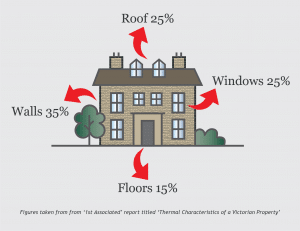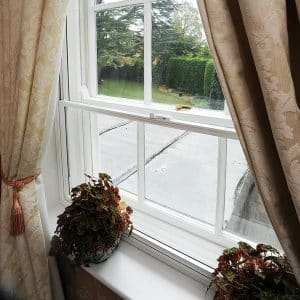Tips for Cutting Home Energy Usage
Navigating the Past: Cutting Energy Use in Your Period Home
When it comes to shopping around for your home energy supplier, how often do you review the
market? Ofgem’s latest findings from their September 2020 report show that, from January to July 2020, 2.5 million customers switched gas supplier and 3.3 million customers switched electricity supplier. And with the cheapest available tariff at around £807 a year – compared to an average standard tariff coming in annually at a whopping £1,125 – you can see that it’s a valuable use of your time to look into switching.
How to start saving energy
But what else can we do to cut our home energy bills? Ofgem suggest the following tips, which are easy
ways to reduce energy waste, throughout the year:
- Switch to energy saving lightbulbs and turn lights off when you leave a room
- Turn taps off fully – a dripping hot tap can waste up to half a bath full in one week alone
- Dry laundry outside when the weather allows, reducing tumble dryer usage
- Wash full loads in your machine – two half loads use more energy
- Close curtains and blinds at dusk to stop heat from escaping

It’s also a sensible idea to check for heat loss from draughty windows. And if you’re lucky enough to have
timber sash windows, this is something you’re probably very familiar with. So, what’s the best way to
deal with this issue?
Embracing Efficiency in Historic Elegance
The Timeless Allure of Period Homes
Owning a period home is like holding a piece of history in your hands—a charming narrative of bygone eras, intricate architecture, and a unique sense of character. However, with this timeless charm comes the challenge of making these historic spaces more energy-efficient. Let’s explore how you can seamlessly cut energy use in your period home without compromising its distinctive allure.
Assessing the Energy Landscape
The Unique Challenges of Period Properties
Period homes, often built with materials and design philosophies of their time, pose distinctive challenges when it comes to energy efficiency. Drafty windows, inadequate insulation, and outdated heating systems can make energy conservation a complex puzzle.
The Importance of an Energy Audit
Before embarking on any energy-saving initiatives, conducting a comprehensive energy audit is essential. This assessment helps identify key areas of energy loss and provides a roadmap for prioritizing improvements tailored to your period home’s specific needs.
Windows of Opportunity: Upgrading Glazing and Draughtproofing
Transforming Draughty Windows
Retaining Historic Charm with Modern Glazing
Preserving the aesthetic appeal of original windows while enhancing energy efficiency is achievable through modern glazing options. Double glazing, for instance, provides an additional layer of insulation without compromising the authenticity of your period home.
Draughtproofing as a Defence Mechanism
Draughty windows are a common woe in period properties. Draughtproofing solutions, like those offered by Ventrolla, can seamlessly address gaps and cracks without altering the historical character of your home. Learn more about Ventrolla’s draughtproofing solutions.
Install draught proofing
Whether your original windows need repairing or restoring, or they’re beyond help and need replacing,
you may be relieved to hear that sash window draught-proofing is extremely efficient. The Ventrolla
Perimeter Sealing System is a discreet and innovative solution for keeping your home warmer and reducing
energy bills. Having evolved over 40 years, this unique, precision-manufactured system has solved the
problem for thousands of UK households. It can also stop rattles, prevent water and dust from entering
your home and reduce outside noise. In a range of colours, the VPSS will blend seamlessly into your
home, too.

Heat loss in your home
Think about double glazing
Double glazing doesn’t have to mean compromising on the character of your home. Ventrolla can make
slimline, double-glazed sashes and install them into your existing sash box, or manufacture new
hardwood double glazed sash windows. Both ensure modern energy performance and sympathetic
styling go hand in hand.
Consider secondary glazing
Secondary glazing enables you to keep your original windows and yet still enjoy modern home comforts
and reduced energy loss. It can also add a welcome layer of security to your home and is very efficient at
reducing the noise from outside. In a choice of Traditional or Heritage styles, Ventrolla’s secondary
glazing is a discreet solution that can cut energy bills.

Secondary Glazing
Upgrade your window dressings
As Ofgem recommend, closing your curtains as it gets dark is a great way to stop warmth from escaping,
keeping your room looking and feeling cosier. But you can boost the heat-retaining quality of your
curtains or blinds by opting for thermal linings or choosing heavy insulating fabrics like velvets and
brocades – which not only keep the heat in but are a perfect complement to the style of a period home.
Insulating the Unseen: Walls, Roofs, and Floors
Unveiling the Potential of Insulation
The Role of Wall Insulation
Incorporating wall insulation, either internally or externally, is a transformative step in enhancing energy efficiency. This not only regulates temperature but also contributes to the longevity of the structure.
Roof and Loft Insulation: A Top Priority
Heat rises, and so does the need for effective roof and loft insulation. By preventing heat loss through the roof, you create a cosier living environment while reducing the strain on your heating systems.
Addressing the Chill from Below
Don’t overlook the impact of insulated floors in creating a thermally comfortable atmosphere. By insulating beneath floorboards, you can prevent heat from escaping and elevate the energy efficiency of your period home.
The Heating Conundrum: Balancing Comfort and Efficiency
Navigating Heating Solutions
Embracing Modern Heating Technologies
While preserving the original charm of fireplaces and traditional heating systems, integrating modern technologies can significantly improve energy efficiency. Consider options like high-efficiency boilers, smart thermostats, and underfloor heating to strike a balance between comfort and conservation.
Zoning for Efficiency
Implementing heating zones within your period home allows you to regulate temperature based on usage patterns. This targeted approach ensures that energy is directed where it’s needed most, optimizing efficiency without compromising comfort.
The Light of Efficiency: Upgrading Lighting Systems
Illuminating the Green Path
Embracing LED Technology
Period homes can benefit greatly from the energy efficiency of LED lighting. These modern fixtures not only reduce energy consumption but also offer versatility in design, seamlessly blending with the aesthetic of your historic spaces.
Smart Lighting Controls
Implementing smart lighting controls, such as motion sensors and programmable timers, ensures that lights are only in use when necessary. This not only conserves energy but also adds a layer of convenience to your daily living.
A Greener Future in Period Splendor
Balancing Tradition and Efficiency
In the pursuit of cutting energy use in your period home, the key lies in finding a harmonious balance between preserving historical charm and embracing modern efficiency. By addressing windows, insulation, heating, and lighting with a strategic approach, you can transform your period property into a beacon of energy-conscious living—where the past and the future coexist seamlessly.
If you like to discuss how upgrading your timber windows can help cut your energy bills, contact us today, we’re always happy to help.
